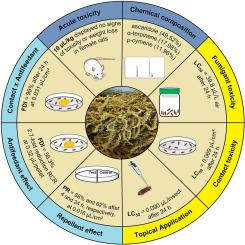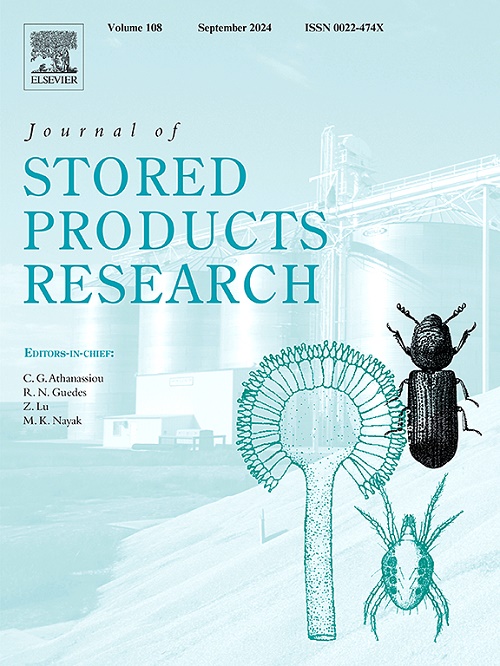在实验室和模拟贮藏条件下,凤蝶籽精油对蓖麻虫的杀虫和行为效果
IF 2.7
2区 农林科学
Q1 ENTOMOLOGY
引用次数: 0
摘要
摘要本研究旨在评价氨brosioides种子EO (DAEO)的化学成分、拒食性、驱避性、熏蒸性、接触性和外用毒性对主要储粮昆虫castaneum成虫的毒性。并对其在模拟贮存条件下的驱避性和对雌性大鼠的急性毒性进行了评价。GC-MS分析表明,DAEO具有高含量的天冬酰胺(49.52%)、α-萜烯(17.98%)和ρ-伞花素(11.96%)。熏蒸法24 h LC50值为39.8 μL/L,接触法为0.069 μL/cm2,直接施药法为0.090 μL/虫。拒食生物试验结果表明,DAEO从最低浓度开始显著降低了所有营养指标,在0.32 μL/粒时,摄食抑制指数(FDI)降低56.3%,相对摄食率(RCR)降低2.7倍。在0.031 μL/cm2浓度下,非致死浓度的接触暴露表现出很强的FDI, 24 h后达到99%。在驱避生物实验中,DAEO在最低浓度为0.016 μL/cm2时,4 h和24 h的驱避率分别为88%和62%。在模拟贮藏条件下,驱避效果较好,24 h后处理袋内的昆虫比例约为对照袋的一半,但72 h后驱避效果下降。在急性毒性方面,10 μL/kg剂量对雌性大鼠没有毒性和体重减轻的现象。本研究强调了DAEO的多重效应、安全性及其在模拟储存条件下的有效性,表明该EO可以被认为是一种有前途的生态友好型杀虫剂。本文章由计算机程序翻译,如有差异,请以英文原文为准。

Insecticidal and behavioral effects of Dysphania ambrosioides seed essential oil against Tribolium castaneum under laboratory and simulated storage conditions
This study aims to evaluate the chemical composition, antifeedant, repellent, fumigant, contact, and topical toxicity of Dysphania ambrosioides seeds EO (DAEO) against adult Tribolium castaneum, a major stored product insect. The repellency under simulated storage conditions and the acute toxicity to female rats were also assessed. GC-MS analysis revealed that DAEO was characterized by high levels of ascaridole (49,52 %), α-terpinene (17,98 %), and ρ-cymene (11,96 %). In insecticidal bioassays, the LC50 values after 24 h were 39.8 μL/L air for fumigation, 0.069 μL/cm2 for contact, and 0.090 μL/insect for direct application. The results from the antifeedant bioassay showed that DAEO significantly decreased all nutritional indexes starting from the lowest concentration, with a 56.3 % feeding deterrence index (FDI) and a 2.7-fold reduction in the relative consumption rate (RCR) at 0.32 μL/pellet. Contact exposure to non-lethal concentrations demonstrated strong FDI, reaching 99 % after 24 h at 0.031 μL/cm2. In the repellency bioassay, DAEO exhibited a strong repellent effect with 88 % and 62 % of PR (percentage of repellency) observed after 4 and 24 h, respectively, at the lowest concentration of 0.016 μL/cm2. Under simulated storage conditions, strong repellency was observed, with the proportion of insects in treated bags approximately half that in control bags after 24 h. However, this activity decreased after 72 h. Regarding acute toxicity, a dose of 10 μL/kg showed no signs of toxicity or weight loss in female rats. This study highlights the multifaceted effects of DAEO, safety, and its effectiveness under simulated storage conditions, suggesting that this EO can be considered as a promising candidate to develop an eco-friendly insecticide for controlling T. castaneum.
求助全文
通过发布文献求助,成功后即可免费获取论文全文。
去求助
来源期刊
CiteScore
5.70
自引率
18.50%
发文量
112
审稿时长
45 days
期刊介绍:
The Journal of Stored Products Research provides an international medium for the publication of both reviews and original results from laboratory and field studies on the preservation and safety of stored products, notably food stocks, covering storage-related problems from the producer through the supply chain to the consumer. Stored products are characterised by having relatively low moisture content and include raw and semi-processed foods, animal feedstuffs, and a range of other durable items, including materials such as clothing or museum artefacts.

 求助内容:
求助内容: 应助结果提醒方式:
应助结果提醒方式:


